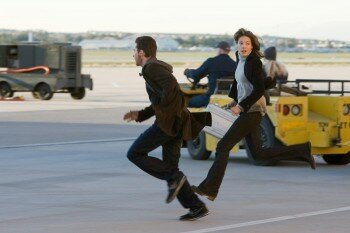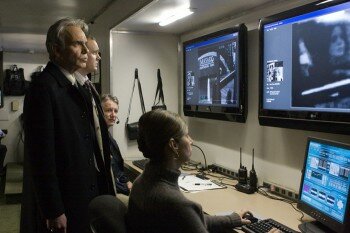I’ve come to the conclusion that originality doesn’t sell movie tickets anymore. If it’s not a sequel, remake or adaptation topping the box office, then it’s most probably a film that borrows heavily from a range of superior films. The importance of the word to filmmakers has clearly been replaced by the term ‘quantity’. To sell a film nowadays it’s got to have an abundance of chase sequences, gun fights, explosions, flipping cars and CGI. When making the action/thriller Eagle Eye, director D.J Caruso clearly took this notion and ran with it. More specifically, he got Shia LeBeouf to quite literally run with it…for 118 pointless and preposterous minutes.
Struggling University dropout Jerry Shaw (Shia LaBeouf) inexplicably finds his bank account overflowing with dirty money and his apartment packed with military grade weapons and explosives. When he receives a mysterious phone call saying that he has been set up for terrorism charges, Jerry is forced to follow the caller’s precise instructions in order to escape and survive. He is unwillingly teamed up with single mother Rachel Holloman (Michelle Monaghan), also contacted by the mysterious caller who threatens to kill her son if she doesn’t comply. Expertly tracking and guiding them through the use of extensive surveillance and satellite networks, the caller helps the two unlikely fugitives elude FBI agent Thomas Morgan (Billy Bob Thorton), whom begins to question whether a third party is involved.
Whilst there is an attempt to explain the never ending chase sequence that is Eagle Eye, it unintentionally comes across as a blatant duplication of far better films. Instead of just borrowing concepts from films such as The Terminator, Enemy of The State, Se7en, I, Robot and North By North West, director D.J Caruso has cut scenes right out of these films, slapped them onto a new reel and superimposed a shocked and bewildered Shia LaBeouf over the top. Consequently, this continual sense of movie Déjà vu quickly turned Eagle Eye into a game of ‘guess the movie parody’, something I’d expect from an episode of Family Guy and not a big-budget Hollywood thriller.
The unoriginal narrative also works hard to discredit any believability from the story. Caruso tries to provoke the same feeling of paranoia towards modern technology as he did with neighbors in Distrubia, however he completely misses the mark. He incessantly tries to force down the throats of the audience the old idea that ‘someone or something is always watching’. The concept loses all credibility when we’re forced to believe that this female at the end of the phone also has the ability to manipulate everything electrical remotely. Given that the film makes no attempt to depict a society or age where this might be plausible to the extent that the film suggests, this uncharacteristic sci-fi element fails to captivate. By the time any sort of explanation is given, which takes a incredibly frustrating 80 minutes to actually occur, it’s far too late to make up for the lack of narrative attention given to the first three quarters of the film.
Maybe I’m being unfair. After all, Eagle Eye is all about the action. In fact, I don’t think I’ve ever seen a film with this much action. As soon as the Jerry picks up the phone for the first time, subtlety is given the boot as the screen simply becomes a canvas for large explosions and long car chases. Although, as much as a enjoy a good action scene, I need there to be a reason for it to exist. Few action sequences in Eagle Eye seem to progress the story or bring anything enlightening to the table; acting as a means to fill in time possibly to mask the fact that the plot isn’t capable of supporting an entire film. If you can look past this, something of which I can’t, then you’ll probably find Eagle Eye to be a lot of fun. The action scenes themselves are quite spectacular, however they frequently fall victim to rapid-fire editing that ultimately dilutes the impact and focus of the scene at hand.
Perhaps the best aspect of the film is its cast. After running from giant robots in Transformers and power hungry Soviet’s in Indiana Jones 4, Shia LaBeouf has become quite good at running from things trying to kill him. Just as capable is Michelle Monaghan at his side, whom despite portraying a character who feels oddly inconsequential to the plot, manages to be a convincing pawn in mysterious caller’s grand plan. Most enjoyable to watch is Billy Bob Thornton as the smart and smug FBI agent, whom delivers some funny little quips. However, it’s LaBeouf who delivers the most fitting and relatable line of the film;
“I don’t know what I’m doing in this room, sir.”
My thought’s exactly…
Conclusion:
Like an overlong Rollercoaster ride; Eagle Eye builds suspense in the initial climb and hits its peak at the first drop of action, but soon becomes tedious and monotonous when the mystery of the caller extends its welcome and the narrative twists and turns fall victim to genre clichés.
 Follow the author Anders Wotzke on Twitter.
Follow the author Anders Wotzke on Twitter.


















